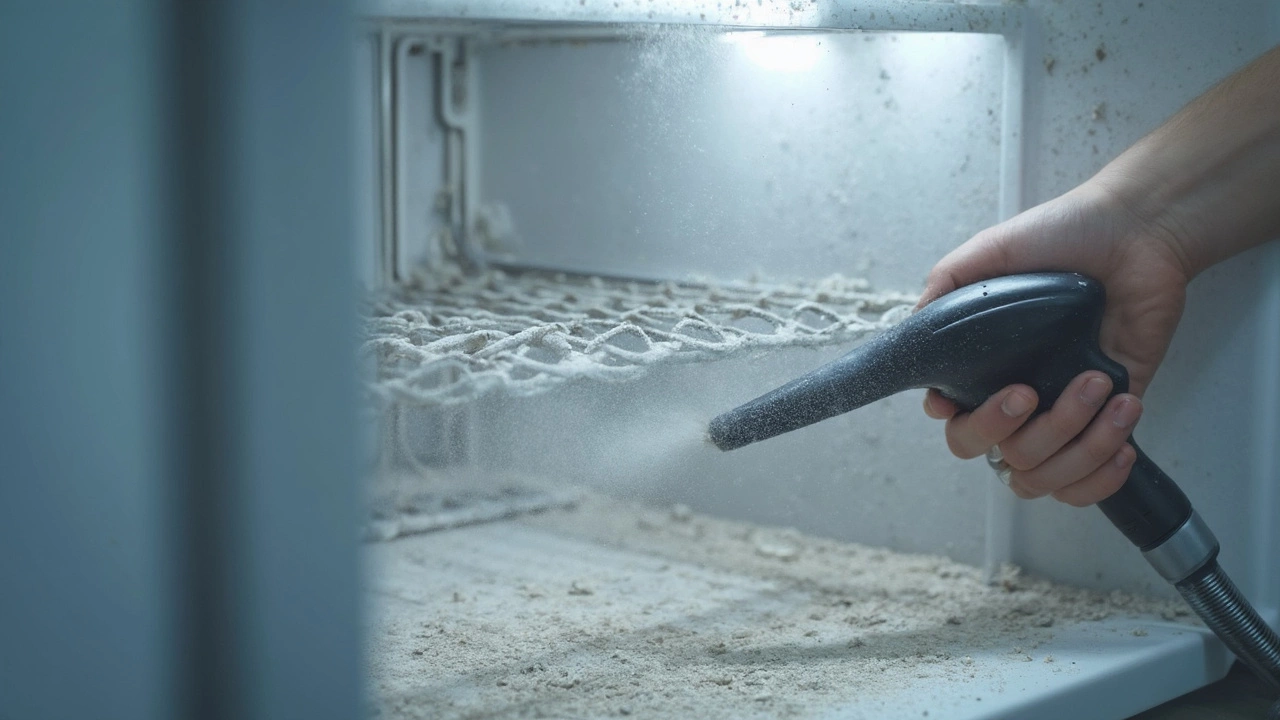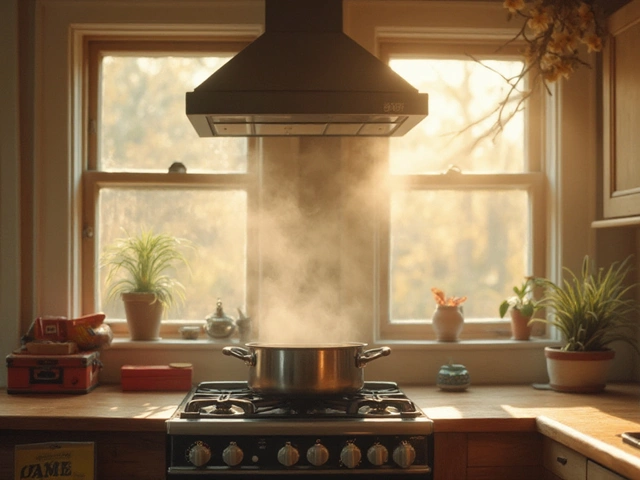So, your fridge is acting up again. The light's on, but the fridge isn't cooling—frustrating, huh? Don't worry; let's sort this out before you need to chuck anything away. First, understand why this can happen. It's usually something simple, like a blocked vent or a thermostat issue. Yes, it sounds technical, but hang tight; I promise it isn't tricky to wrap your head around.
Okay, let's get started with some quick checks. First up, see if the temperature control settings got bumped. It happens more often than you'd think, especially if you have kids like mine, who love to play 'helping hand'. Set it to the correct level again, and that could solve your problem right there.
Common Causes
So, why is your fridge refusing to cool but keeping the light on like a night owl? This might be due to a few usual suspects that are surprisingly common.
Blocked Vents
If you've packed your fridge to the gills with leftovers and all sorts of goodies, you might be blocking the air vents. These vents help circulate cool air around the fridge. When they're blocked, it can affect how well your fridge cools. Simple fix? Clear away any items obstructing these vents.
Thermostat Issues
The thermostat is the brain behind your fridge's cooling operations. If it's on the fritz, your fridge might not maintain the right temperature. Sometimes, it could be something as straightforward as a bumped setting. A quick check and reset might get things back to normal.
Dirty Condenser Coils
Your fridge relies on condenser coils to dump heat outside. If these coils are covered in dust and grime, it's game over for efficient cooling. Give those bad boys a clean; it could make a world of difference.
Faulty Fan
The evaporator fan is crucial for pushing cold air around the fridge. If it's dead or on its last legs, your fridge might struggle to cool. Listen for any unusual noises—a whining or clicking fan might just need replacing.
Other Common Culprits
- Door Seals – If door seals are cracked or not sealing properly, cold air can escape, reducing your fridge's cooling power.
- Power Supply – Seems simple, but check that the power supply is steady. Flickering power can cause cooling issues.
These are the frequent troublemakers. Of course, refrigerators are complex beasts, so it might be a combination of these problems. But check these first before plugging more dollars into repairs!
Simple Checks
So, your fridge not cooling is driving you nuts? Let's tackle this with some straightforward checks that might save you a service call.
Temperature Settings
This might seem basic, but go ahead and check the temperature settings. Sometimes they get knocked or accidentally adjusted, especially if you've had a busy weekend with family gatherings. Ensure it's set between 1.7°C and 3.3°C for the fridge, which is the sweet spot for keeping things chilled.
Blocked Air Vents
Take a peek inside and make sure nothing's blocking the air vents. If air can’t flow freely, the cooling doesn't reach all the areas it needs to. I know, with kiddos around, things just find a way to stack up recklessly. Clear any obstructions, and this might just do the trick.
Condenser Coils
These guys tend to gather dust like you wouldn’t believe. If your coils are clogged, they can't release heat efficiently. Find the coils—usually at the back or bottom of the fridge—and give them a good clean. Best use a vacuum or a coil brush for this task to avoid damaging anything.
The Door Seal
Ever feel a slight breeze when you open the door? That’s a hint. The door seal might be letting in warm air. Check for wear and tear, and use the 'paper test'—place a sheet of paper against the seal and close the door. If it slips out easily, your seal might need replacing.
| Step | What's Checked |
|---|---|
| 1 | Temperature settings |
| 2 | Air vents |
| 3 | Condenser coils |
| 4 | Door seal |
If these quick fixes don't solve your fridge repair issue, it might be time to look at more technical solutions or consider calling in the professionals.

Maintenance Tips
Alright, let's keep your fridge running smoothly so you won't have to deal with cooling issues too often. Maintenance is like brushing your teeth; a little regular attention goes a long way.
Keep Coils Clean
The back or bottom of your fridge has condenser coils which can get all dusty and gunky over time. This can stop your fridge from cooling efficiently. You should give them a clean up every six months.
- Unplug your fridge (safety first!).
- Use a vacuum to suck up loose dust from the coils.
- Grab a coil cleaning brush (you can find these at hardware stores) to reach spots the vacuum can't.
Ensure Door Seals Are Tight
Door seals, often called gaskets, can wear out, causing cold air to leak. Shut the door on a piece of paper and try pulling it out. Easier than it should be? Time to replace those seals.
Temperature Settings Matter
Set your fridge temperature to around 4°C (40°F) and your freezer at -18°C (0°F) to ensure everything stays fresh without overworking the appliance. If you're fiddling with controls a lot, you might end up with a fridge not cooling properly.
Don't Overload It
Cramming the fridge makes it hard for air to circulate, affecting cooling. Keep some space clear, especially near the air vents.
Regular Defrosting for Older Models
If your model isn't frost-free, defrosting is key. Thick ice buildup isn't just a hassle; it stops your fridge from cooling effectively.
Check Your Outlet
Lastly, make sure your fridge is plugged into a proper outlet. Avoid extension cords if you can; they might not deliver enough power for efficient cooling.
With these steps ticked off your list, your fridge should stay in top-notch shape, cooling like a champ and keeping those groceries fresh.
When to Call a Professional
So, you've done your checks, and your fridge is still being stubborn. That's when it might be time to call in the pros. Sometimes, these issues go beyond a simple DIY fix, and snagging a professional will save you time, effort, and possibly money in the long run.
Signs You Need Expert Help
- Fridge not cooling even after resetting the temperature. If you've made all the basic adjustments, and it's still warm inside, an expert can pinpoint the issue quickly.
- Strange noises coming from the back or bottom of the fridge. Sounds like clicking, buzzing, or humming may indicate electrical issues or motor problems that need a trained eye.
- If you've noticed water pooling beneath your fridge, there might be a leak, which is best left to someone who knows their way around seals and pipes.
- Whenever there's a broken fan or compressor issue, it's essential to consult a professional, as these parts are intricate and crucial for effective cooling.
Attempting to fix these on your own could result in making matters worse. When experts are involved, they also come with the right tools and often carry spare parts, ensuring that fixes are done in a jiffy.
Choosing the Right Service
It's practical to shop around a little when looking for a repair service. Here are some tips:
- Check reviews and ratings online to gauge reputation and reliability.
- Ask for quotes from a couple of places. You've got options, so make sure you're getting a fair deal.
- Look for technicians with certification or substantial experience with your specific fridge repair problems.
Sometimes, spending a little more upfront for quality service prevents further issues down the track. Maybe you'll even learn a thing or two about your appliance from the professionals!







